Successful captive breeding of the eastern indigo snake is within the capability of anyone willing to put forth a little extra effort, patience and attentiveness.
Revered for its alert and intense nature, its intelligence, and for its fearless but genuinely friendly temperament, the eastern indigo snake (Drymarchon couperi) is considered by many to be the jewel of the reptile world. It has also a well-earned reputation as the one snake species that will form an obvious bond to its owner. Listed as a threatened species and protected by the Endangered Species Act, it is illegal to take eastern indigos from the wild. In nature, they are found in Alabama, Georgia and Florida. Captive-bred specimens are legal to keep and breed in most states, but check your local laws first.
Read More
Eastern Indigo Snake Species Profile
Conservation Efforts Brings Eastern Indigo Snake Back to Georgia
Climbing A Tree to Save an Eastern Indigo Snake
Indigo Snake Enclosure
Adults can be kept individually in conventional, front-opening cages or in sliding trays or rack systems. Adult enclosures should have 6 to 8 square feet of floor area and between 8 inches and 24 inches of vertical height. I use absorbent bedding, consisting of a mixture of wood shavings and pelletized wood pulp or paper pulp. Indigo snakes require a continuous source of water. I prefer a water bowl that is 6 inches across but isn’t quite large enough for the animal to soak in. During non-breeding periods of the year, one end of the cage should be warmed to 82 to 84 degrees for 12 hours each day using under-cage heating. The cool side should be in the mid to high 70s. At night, when the heating is turned off, the room temperature should not drop below 70 degrees. Keep humidity between 50 and 70 percent.
Indigo Snake Breeding Tips
The eastern indigo snake is considered a winter breeder, meaning that in the wild, it will most often copulate between October and January. In reality, males will attempt copulation with any ovulating female they encounter, no matter the time of year. When a female eastern indigo ovulates, she produces a pheromone that is released from her skin. This pheromone creates a track along the ground wherever she moves. Male eastern indigos are so sensitive to this scent that they can locate an ovulating female from a great distance. So, the first priority in getting eastern indigos to breed is getting the females to ovulate.
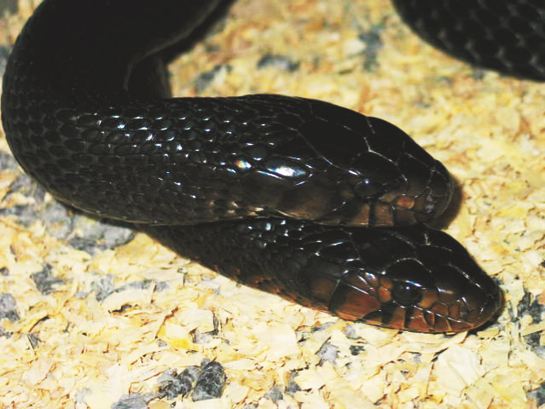
Robert Bruce
The eastern indigo snake is considered a winter breeder, meaning that in the wild, it will most often copulate between October and January.
A Mystery Revealed
About 12 years ago, in early July, I noticed that every time I entered my snake room, all three of my adult males were at the front of their cages, moving continuously back and forth. The females did not move in their cages at all. I suspected that the males wanted to mate, but July was just too early. After three weeks of watching this, I gave in and put one adult female into each cage. I suspected that the males would aggressively try to mate, but instead they showed no interest in the females. I assumed that their restless behavior was due to some other cause.
After years of breeding experience, it has become clear to me that my first suspicions were actually correct. When eastern indigos pace their cages, it is usually due to one of four things: they have recently defecated (they don’t like the smell of their own feces), the temperature is too warm, they are ready to lay eggs and are looking for a moist location (females), or they want to mate (males). In this instance, only the males were moving, and their restlessness continued for weeks, so none of the first three explanations could be right. The answer was that one of the females in the room had ovulated. I just didn’t put the right female into any of the males’ cages!
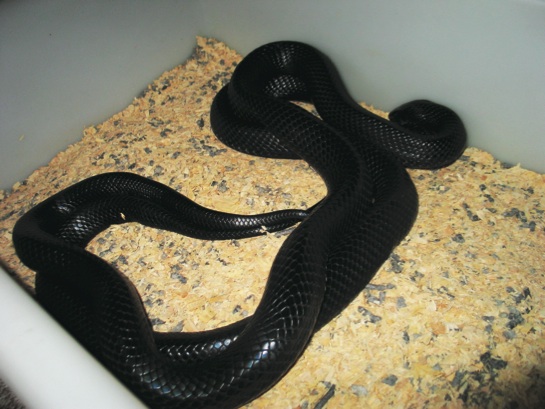
ROBERT BRUCE
When ready to initiate mating, the author puts the male and female together at the end of the day, and shuts off the room heaters but keep the windows closed.
I’ve since determined that the environmental cue that stimulates the female eastern indigo to ovulate is the decreasing day length associated with the fall season and the onset of winter. In the southeastern United States, where eastern indigos are native, ovulation typically occurs in October. In captivity, if the snakes are kept in a room with artificial light at night, then the seasonal day length cue will be disrupted. To ensure success, a breeder must expose the snakes to a natural daylight cycle, peaking at roughly 15 hours of light in the summer and diminishing to roughly 11 hours in mid-winter.
What happened in my circumstance was that I had a new adult female in my collection that came from an environment that had artificial light at night. This had extended her day lengths and upset her seasonal balance. When she came into my environment, with natural lighting and normal day length, the change was dramatic enough to cause ovulation. In the years since, I have never again observed restless males in July.
Indigo Snake Cooling And Breeding
Many colubrid breeders brumate their snakes in the winter. The ambient temperature is lowered to 45 to 55 degrees Fahrenheit for two to four months, and during which time, the snakes aren’t offered food. When the temperature warms in the spring, it triggers breeding. However, eastern indigos aren’t spring breeders. They are known to inhabit vacated gopher tortoise burrows for protection from temperature extremes, and winter underground temperatures in the southeast don’t get below 65 degrees. Their dark blue-black pigment allows them to readily warm up in the morning sun to reach their comfort zone in the low 80s on most winter days. Conventional wisdom among many indigo breeders has therefore been to cool the animals at night only, down to the mid 60s, and to warm them each day to the daytime temperature they are kept at year-round.
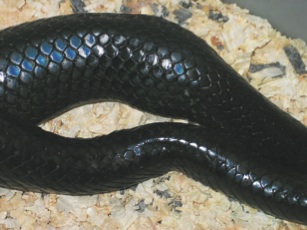
Robert bruce
Egg bump.
I was curious as to whether this nighttime cooling was important for breeding of eastern indigos. Given that I had a plentiful hatch in 2005, I decided to experiment the following breeding season. Throughout that breeding season I turned the heaters off at night but kept the windows closed, so it never dropped below 75 degrees. I raised the daytime temperature to 82, as I normally do in the winter. Mating went great, and come January, when mating was finished, I could feel and even count the eggs inside each female. After egg laying in March, I had close to 200 eggs from 16 females. Unfortunately, the vast majority of the eggs weren’t fertile. By the time hatching was over at the end of July, I had a net total of only 31 hatchlings.
Two years later, I experimented in the other direction. By taking the screen off the snake room window and positioning a pedestal fan to blow the air from the room directly out the window at night, I was able to obtain nighttime lows of 55 degrees during the mating season. As before, I warmed the cages to the low 80s during the day. Come hatching time the following July, I was left with a bounty of 91 hatchlings, and these came from only 10 females. On a per-female basis, this was the best I’d ever done.
My interpretation of these observations is that whereas day length plays the primary role in female fertility, it is temperature that plays the primary role in male fertility. Although I don’t have explicit evidence yet, I suspect that such low nighttime temperatures may be necessary for proper sperm development in the male.
My observations also suggest that during the mating season, male eastern indigos in the wild aren’t spending their nights underground. Transponder studies have shown that males travel many miles to look for females during the mating season, whereas females stay put in a relatively small home range. My conclusion is that females inhabit animal burrows throughout the winter to take shelter from the nighttime cold, but males, because they are in a new and unknown location every night, spend most nights above ground and are therefore exposed to lower nighttime temperatures.
I begin nighttime cooling in mid-September, and earlier if possible. This allows for at least six weeks of cooling before the first scheduled matings. Productive matings in eastern indigos can occur from ovulation time in October until at least the end of February. I have successfully mated single adult males with as many as four different females during this period.
Indigo Snake Feeding and Breeding
The nearby presence of ovulated females has an inhibitory effect on the male indigo’s feeding response. This is a protective phenomenon that minimizes the possibility that the male will accidentally see the female as food — indigos are snake-eaters, and they are known to attack their prey first and think later. I have found that for a male to mate four females and be fertile for each mating, he will have eat regularly during the mating season; otherwise, he will literally run out of the energy and nutrition he needs to mate and be fertile. For this primary reason I have chosen to use a neutral enclosure for mating. If the female were to be placed into the male’s cage, the scent track she would leave would be so inhibitory to the male’s feeding response that he would stop eating entirely. Conversely, if the male were to go into the female’s cage, the female’s territorial instinct may cause her to attack and possibly kill the male.
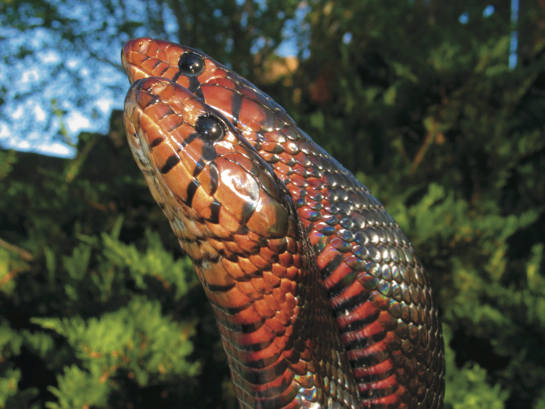
ROBERT BRUCE
Adult eastern indigos typically reach between 51⁄2 and 7 feet in length. The author recommends waiting until they reach 5 feet long and 5 years of age before breeding them.
When ready to initiate mating, I put the male and female together at the end of the day, and I shut off the room heaters but keep the windows closed. I use a mating enclosure that is 5 feet in length by 11⁄2 feet wide but only 5 to 6 inches in vertical height, and containing the same bedding I use for the cages. As the mating environment transits slowly down in temperature, the male will usually have a strong desire to copulate. I’ve found that 76 degrees is the best temperature to initiate mating. Snakes mate by feel, not sight, and both the male and female must actively participate. The visual stimulus of a larger male may induce a fear response in the female, which is not helpful, so the dark environment is beneficial. If the temperature is too warm, or if the female is focusing on her visual perceptions, she may refuse to be mated and will attempt to slap the male in the face with her tail. This may also happen if the female has been recently mated, has never mated before, or if she hasn’t ovulated yet. For all his strength and intensity, getting slapped in the face is a serious turn-off for a male eastern indigo. Just a few slaps and that may be the end of his desire.
At 76 degrees, mating will last about nine to 10 hours. Some breeders have reported mating durations of 24 hours or more, but this may be because they didn’t positively verify the lock-up (eastern indigos can appear to be mating when they really aren’t) or because the male and female separated and then locked up a second time.
Once mated, females become resistant to further mating attempts for about six weeks. This may be due to the presence of a copulatory plug. After this six-week period, the female becomes receptive again. Females that have successfully mated any time before the middle of January will lay eggs during March or early April. If a female’s first successful mating has occurred later, egg laying will be delayed, with a minimum gestation period between mating and egg-laying of two months.
When the matings are finished in mid-January, and until egg-laying is complete, nighttime cooling should be terminated and the heated side of the females’ cages should be set at 80 degrees. Although eastern indigos are normally comfortable in the low to mid-80s, my gravid females can become uncomfortable above 80 degrees. During this period when the cage heating is turned off at night, I do not let the ambient temperature fall below 75 degrees.
Indigo Snake Shed And Egg Laying
Some females lose their appetite in late-January or February, and this indicates that the next shed will be the pre-lay shed. Females that have successfully mated by mid-January are remarkably synchronized in the timing of their pre-lay sheds. It is critical to mark the exact date of this shed. The large majority of gravid females will lay their eggs between 15 and 20 days later. I continue to feed females up until 10 days past shed. This is essential because the lack of food during the weeks before egg laying is a primary cause of egg-binding in captive eastern indigos. I always have food items available that these snakes particularly like to eat. Eastern indigos find the scent of mouse or chicken much more attractive than the scent of rat. Knowing this helps me get a meal into them when they are reluctant to eat.
After 10 days past their pre-lay shed, I stop feeding females because traces of urine from a recent meal may be accidentally released onto the eggs during laying, and this will weaken the shells, causing molding and/or rupture.
Indigo Snake Egg Laying Preparation Tips
Three to four days before the female lays her eggs, she searches for a moist location. Her restless movement starts in the morning, and as the time of egg-laying nears, her motions appear more frantic and extend later into the day. As soon as her search starts, provide her with an egg box containing a moist sphagnum moss substrate. I use a translucent storage box with a floor space of 8 inches by 12 inches and 41⁄2 inches deep, with a hole cut in one end for entrance and exit. It is important to prevent the eggs from being laid on the cage floor because they will quickly dry out and will not be recoverable.
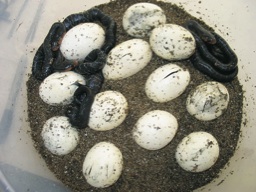
Robert Bruce
Eastern indigos can be kept together for the first two weeks after hatching, but then they should be transferred to individual cages to prevent cannibalism.
The female will go in and out of her egg box dozens of times before finally laying. Egg laying normally begins during the night and each egg takes about 20 minutes to emerge. The female will appear to be in an almost-comatose state during this time. During egg laying, the slightest movement of the cage, and even peering into the eggbox at night with a flashlight, can cause the female to stop. I check the egg box in the morning from outside the cage. When I notice eggs visible against the dark sphagnum moss, I give the female until the middle of the day, and then I open the egg box and carefully palpate her to make sure she has laid all of her eggs.
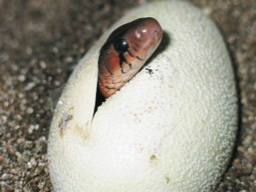
ROBERT BRUCE
An indigo snake pipping.
Healthy indigo females typically lay 10 to 14 eggs. The first and last eggs in a clutch are more likely to be misshapen, hardened or infertile, and these can cause egg binding. Fortunately, these infertile eggs are usually easy to manually express from the female, if this is done within the 24-hour window following the start of laying. During gestation, careless handling of a gravid female can damage the egg closest to the vent, causing it to harden. Hardened eggs are more difficult for the female to pass and can cause the entire clutch of remaining healthy eggs to become bound.
As the newly laid eggs dry, the shells harden. Infertile eggs usually remain soft, wet and slimy. Position the good eggs one-third of the way down into a 1:1 mixture by weight of vermiculite and water. I mark the top of each egg before transfer, so that I can place them into the vermiculite in the exact positions in which they were laid. Incubation will take about 105 days at 78 degrees in 100-percent humidity, and care should be taken during this time to insulate the eggs from shock and vibration.
Eastern indigos can be kept together for the first two weeks after hatching, but then they should be transferred to individual cages to prevent cannibalism. They will have completed their first shed by this time. They possess an internal yolk sac, which feeds them for at least a month after hatching. Although some hatchlings will eat right away after their first shed, I find it easier to wait until they are 4 to 6 weeks old before offering food. Frequent handling during this period will alleviate the fear of humans that hatchling indigos will naturally have and will help them to focus on their food when the time comes. I offer frozen/thawed pinky mice with their heads crushed for the first several meals. I’ve also found that scenting the food items with feeder goldfish can sometimes help persuade a reluctant hatchling to eat.
Successful captive breeding of the eastern indigo snake is within the capability of anyone willing to put forth a little extra effort, patience and attentiveness. The satisfaction that comes from being part of a new generation of eastern indigos is an experience that all reptile-lovers should have the opportunity to enjoy.
Robert Bruce is a professional breeder of eastern indigo snakes. He provides animals to individuals and institutions across the United States.



